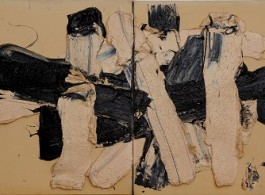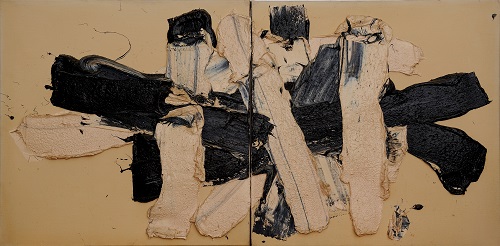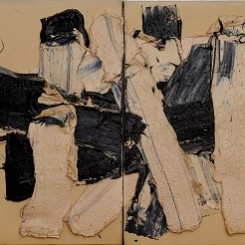“Detached from Colour”
Pearl Lam Galleries
Hong Kong
Exhibition Dates 18 November, 2016–11 January, 2017 Monday–Saturday, 10am–7pm Venue Pearl Lam Galleries, 6/F, Pedder Building, 12 Pedder Street, Central, Hong Kong
Hong Kong—Pearl Lam Galleries is delighted to present Detached from Colour, a solo exhibition by Beijing-based artist Zhu Jinshi, at its Pedder Building space. The exhibition, which comes three years after Zhu’s previous solo show at the Hong Kong gallery, will include black and white abstract works from the 80s and 90s which have never been exhibited before and that were carefully selected after long discussions between the artist and Pearl Lam. It will also highlight 16 all-black, all-white, and black-and-white abstract works created by Zhu Jinshi around the year 2015. Pearl Lam believes the link between painting and installation is interpreted with a unique style in Zhu Jinshi’s artwork. Unlike Anselm Kiefer, Zhu does not use the themes of painting and installation to work together with each other, nor does he use paintings to back up his installations such as in the work of Richard Serra; instead, he uses painting and installation as totally opposite forms to challenge one another. However, the continued appearance of black and white forms throughout the artist’s career subtly defends the inextricable link between painting and installation, and, in a quiet way, reveals artworks that possess an extraordinary Eastern character.
The title of the exhibition emerged from the crux of Zhu’s dialogue with Josef Ng, the Galleries’ Managing Director – Asia, in which they discussed how Zhu is re-exploring the concept of painting’s visual form, using piles of black and white paint to fuse together contemporary abstract painting and non-Western modes of experience. The concept of “detached from colour” is not about removing the visual experience of colour; rather, it is about taking traditional aesthetics and transforming them into a contemporary concept. In regard to how a painting’s colour is defined, Eastern aesthetic theory is distinct from the West. The use of black and white is not only at the heart of traditional Eastern painting, but it is also a style of contemporary Chinese painting. Chinese ancient philosophy encourages returning to one’s true natural state. As concluded by aesthetician Zong Baihua, “When wonder and brilliance reach the very end, they become ordinary.” Detaching from colour can be understood as the artist pursuing in a spiritual state the idea of “non-abidance”. In view of this, Zhu Jinshi’s black and white paintings are not only conceptual abstract paintings, but are also an effort to fuse Eastern aesthetics into contemporary abstract art. It is within these overlapping contexts that Zhu’s colourless paintings provide the viewer with both a visual sensory experience and a non-visual meditative space.
Naturally the sensory dimension that these artworks provide is not only situated between black and white; it is also established in the metaphorical space between the abstract blocks of colour and forms. Compared to Zhu’s signature thick paintings prior to this exhibition, the works on show here more clearly reveal fragments of the artist’s individual ideas, imagination, and memories. The imagery of the piece Leafless Grand Lotus is inspired by Laozi’s Dao De Jing in which the philosopher writes, “Great integrity seems like disgrace. . . . The great image has no form.” As the viewer approaches the painting, the image of the lotus flower floating on the surface of the water is replaced by the heaviness of the paint itself. The title of Zhu’s painting Birds Flying Back Together comes from Tao Yuanming’s pastoral poetry. The black paint entrenched in the top right of the canvas looks as if it could jump off the edge of the painting at any time, while the blank space in the lower left of the painting allows sufficient thoroughfare for the movement of the birds. The energy of the painting is derived from the birds pushing beyond the canvas towards the misty mountains of the poem.
In Black Tile Temple, the artist pushes continuous, overlapping blocks of black paint from the bottom of the canvas to form three vertical lines that run parallel to the side edges of the painting. Each block of paint stands alone and only touches the other block at its edge. These rows are similar to the arrangement of roof tiles on courtyard houses in Beijing. Coincidentally, Zhu’s early years in Beijing were also spent in a courtyard house community that neighboured the secluded Guanghua Temple. The bell of this temple would frequently resound over the courtyard roofs; thus, the memory of this distant sky is preserved in the diagonal structure of Guanghua Temple.
“Detached from colour” means not to abide in any one place and is situated between traditional aesthetics and contemporary concept. Colour becomes ordinary and naïve, images melt into abstraction, blocks of paint and empty spaces shift and change, and concepts move between the senses and experience. In surveying the recent creative practice of the artist, the use of black and white not only conveys the integration of an experimental painting concept and an independent Eastern spirit, but also becomes a hidden and extended thread between the artist’s creative expressions at different periods of time.



